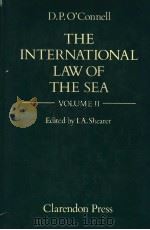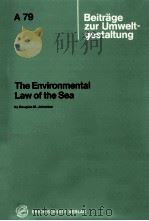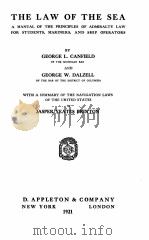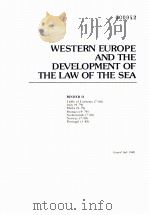《THE INTERNATIONAL LAW OF THE SEA VOLUME 2》
| 作者 | 编者 |
|---|---|
| 出版 | CLARENDON PRESS |
| 参考页数 | 1201 |
| 出版时间 | 没有确切时间的资料 目录预览 |
| ISBN号 | 0198254695 — 求助条款 |
| PDF编号 | 811862728(仅供预览,未存储实际文件) |
| 求助格式 | 扫描PDF(若分多册发行,每次仅能受理1册) |

Chapter 16 Maritime Boundaries635
1.Whether Equidistance is Presumptive637
2.The Legal Meaning of ‘Straight' Lines639
3.The Definition of ‘Nautical Mile'643
4.Large and Small-Scale Nautical Charts645
5.Relevance of Navigational Practice to Length of Closing Lines647
6.Location and Proof of Boundaries648
(1) The Horizontal Datum and Geodetic Spheroid648
(2) Construction of Boundary Lines649
7.Location of Position650
(1) Fixing Position in Relation to Seaward Boundaries650
(2) Artificial Aids to Location655
Chapter 17 Delimitation o f the Territorial Sea658
1.Customary Law658
(1) Theoretical Solutions658
(2) State Practice663
(a) The Arbitrations663
(b) Treaty and Diplomatic Practice667
2.Article 12 of the Geneva Convention673
(1) The Codifications674
(a) The Institut de Droit International, 1894—1912674
(b) The International Law Association, 1895—1924674
(c) The Hague Codification Conference, 1930675
(2) The Geneva Conference, 1958676
(a) The Adoption of Article 12676
(b) The Construction of Article 12677
3.Special Questions of Delimitation679
(1) Elimination of Pockets of High Seas679
(2) Adjacent States with Different Limits681
(3) The Effect of Geographical Changes682
Chapter 18 Delimitation of the Continental Shelf and EEZ684
A. Continental Shelf684
1.Conventional and Customary Rules of Delimitation684
(1) The Geneva Convention684
(2) Customary Law685
(3) The Montego Bay Convention689
2.The Relationship Between the Geneva Convention, the Montego Bay Convention, and Customary Law690
3.The Difference Between Apportionment and Delimitation691
4.Equitable Delimitation693
5.The Rule for Delimitation699
(1) The Unitary or Disparate Character of the Rule699
(2) Equidistance and Negotiation700
(3) Whether Equidistance has Primacy700
(4) Equidistance and Special Circumstances703
6.Special Circumstances705
(1) The Conventional and Customary Rules705
(2) The Scope of Special Circumstances707
(3) The Catalogue of Special Circumstances708
(a) Geographical Circumstances709
(b) Common Mineral Deposits711
(c) Navigation and Fishing Rights712
(d) Historical Special Circumstances713
(e) Islands714
7.Other Factors Affecting Delimitation724
(1) Proportionality724
(2) Proximity725
(3) Geomorphological Discontinuities726
B. Delimitation of the EEZ727
1.The Principle of Delimitation727
2.Delimitation from Islands731
Chapter 19 The Theory of Maritime Jurisdiction733
1.The Doctrine of the Territoriality of Ships735
2.The Theory of Jurisdiction in the Territorial Sea737
(1) The Property and Police Theories737
(2) The Debates in R. v. Keyn on the Extent of Jurisdiction in the Territorial Sea739
(3) The Consolidation of the Police Theory741
(4) The Codifications743
(a) The Institut de Droit International, 1894743
(b) The Codifications, 1924—30743
(5) The Sovereignty Theory744
Chapter 20 Jurisdiction Over Shipping747
1.Ships747
(1) The Definition of ‘Ship'747
(2) The Nationality of a Ship750
(3) Use of Flag757
(4) The Connecting Factor in Nationality757
(5) Commonwealth Ships761
2.The International Conventions on Shipping770
(1) Safety of Life at Sea770
(a) Trinity House Rules770
(b) The SOLAS Conventions771
(c) The Safety of Fishing Vessels774
(2) Nuclear Ships and Carriage of Nuclear Material774
(3) Tonnage Measurement775
(4) Load Lines776
3.International Carriage by Sea780
(1) Carriage of Passengers and Baggage780
(2) Liner Conferences782
(3) Carriage of Goods by Sea782
4.Limitation of Shipowners' Liability786
(a) The Merchant Shipping Act, 1894786
(b) The Brussels Convention, 1957787
(c) The IMO Convention, 1976788
(d) Other Conventions788
(e) The Relationship Between the Conventions789
(f) The Conflict of Laws Rule789
5.Distressed, Deserting, and Refugee Seamen790
Chapter 21 Jurisdiction on the High Seas792
1.The Juridical Nature of the High Seas792
(a) Res Nullius792
(b) Res Communis793
(c) Public Domain794
(d) The Theory of Juridicity794
(e) The Theory of Reasonable Use795
(f) The General Principles of the Law of the Sea796
2.The Relativity of the Freedom of the Seas796
3.The Basis of Jurisdiction on the High Seas799
(1) Visit and Search801
(a) The Right of Approach802
(b) Self-Defence804
(c) Responsibility for Unjustified Visit and Search808
(2) Military Practice and Testing809
(3) Nuclear Testing and Danger Zones810
4.Assistance at Sea813
5.Broadcasting at Sea814
6.Submarine Cables and Pipelines819
(1) The Freedom of Laying Submarine Cables and Pipelines819
(2) The Submarine Telegraph Cables Convention, 1884820
(3) The Relationship Between the Conventions822
7.Military Uses of the Seabed of the High Seas824
(1) The Legal Characteristics of the Seabed for MilitaryPurposes824
(2) The Treaty on the Prohibition of the Emplacement of Nuclear Weapons and other Weapons of Mass Destruction on the Seabed and the Ocean Floor and in the Subsoil Thereof826
(3) The Treaty of Tlatelolco, 1967829
Chapter 22 Jurisdiction Over Navigation and Port Access831
1. Control of Navigation831
(1) The International Regulations for Preventing Collisions at Sea831
(2) Traffic Separation833
2. Compulsory Pilotage836
3. Jurisdiction to Charge Tolls837
(1) The Theories Respecting Tolls837
(2) The Danish Sounds Dues Controversy837
(3) The Codifications839
(4) Light Dues841
4. Control of Deepwater Ports842
(a) The Right to Construct Deepwater Ports843
(b) Jurisdiction over Deepwater Ports845
(c) Jurisdiction around Deepwater Ports846
5.Access to Ports847
(1) The Requirement to Observe Navigational Regulations847
(2) The Right of Access to Ports848
(3) Treatment of Ships in Ports849
(4) Facilitation of Ships in Ports851
6.Entry into Ports under Force Majeure or Stress of Weather853
(1) The Theory of Force Majeure853
(2) The Test of Distress855
(3) The Extent of the Immunity856
(4) The Procedure857
(5) Modern Treaty Practice857
(6) Force Majeure in the Law of War at Sea858
Chapter 23 Civil Jurisdiction859
1.The Jurisdiction of the Forum859
(1) Admiralty Civil Jurisdiction860
(a) English Law860
(b) United States Law862
(2) The International Basis of Jurisdiction in Rem865
2.Ships in Territorial Waters867
(1) Arrest of Ships in Territorial Waters868
(a) The Right to Arrest868
(b) Outward-bound, Inward-bound, Anchored, and Hovering Ships869
(c) Arrest for Previous Liabilities870
(d) The Relationship between Article 20 and the Brussels Convention for the Unification of Certain Rules Relating to the Arrest of Sea-going Ships,1952872
(e) Consular Jurisdiction873
(f) The Areas of Sea Covered by Article 20873
(2) The Exercise of Civil Jurisdiction in Personam in the territorial Sea874
3.Collision Suits874
(1) Venue in Collision Suits875
(a) The Brussels Convention, 1952875
(b) English Law875
(c) United States Law876
(2) Choice of Law in Collision Suits877
(a) The International Rule: General Maritime Law877
(b) The Brussels Convention, 1910880
(c) English Law881
(d) United States Law886
(e) Civil Law Systems887
(f) Latin-American Treaties890
(3) Collisions with Offshore Installations890
4.Shipboard Torts890
(1) On the High Seas891
(2) In Territorial and Internal Waters893
(a) English and Scottish Law894
(b) United States Law902
(3) Acts and Omissions on Offshore Installations905
5.Salvage907
(1) The Rights of Salvors908
(2) Salvage of Wreck and Derelict909
(3) Jurisdiction Respecting Wrecks and Marine Archeology911
(a) Ownership of Wrecks912
(b) The Legal Characteristics of Wreck913
(c) Territoriality of Law and Admiralty Droits914
(d) Territoriality of Archeological Legislation918
Chapter 24 Criminal Jurisdiction919
A. Prescriptive and Curial Jurisdictions919
1.The Admiralty Criminal Jurisdiction920
(1) The History of Admiralty Criminal Law920
(2) Ambit and Venue923
(3) The Catalogue of Admiralty Offences926
(4) Colonial Admiralty Jurisdiction927
(a) Ambit928
(b) Venue929
(5) The Admiralty Law Definition of ‘High Seas'931
(6) Acts Outside Ships933
(7) Statutory Jurisdiction933
2.Offences on the High Seas935
3.Offences in the Territorial Sea936
(1) English Law936
(a) Indictable Offences: the Territorial Waters Jurisdiction Act, 1878936
(b) Summary Offences940
(2) The Law of the United States941
(a) Foreign Ships in American Territorial Waters941
(b) American Ships in Foreign Territorial Waters945
(3) French Law946
(a) The Avis of 1806946
(b) The French System in Treaty Law948
(4) Italian Law949
(5) German Law950
(6) Other Countries952
B. Enforcement Jurisdiction953
1.Enforcement in National Waters953
(1) Pre-Geneva Doctrine954
(2) Article 19 of the Geneva Convention on the Territorial Sea and Contiguous Zone (Article 27 of the Montego Bay Convention)956
(a) Inward-bound Ships958
(b) Outward-bound Ships958
(c) Ships in Lateral Passage959
(d) The Implications of ‘Should Not'960
(e) The Requirements of Consular Consultation961
(f) Previous Crimes962
(g) Anchored or Hovering Ships962
(3) Arrest of Public Ships in the Territorial Sea963
2.Penal Jurisdiction in Matters of Collision965
C. Piracy967
1.The International Law Definition of Piracy967
(1) Internal Seizure of a Ship970
(2) Violence by Commissioned Vessels973
(3) Violence by Unrecognized Insurgents975
(4) Action Against Pirates976
(5) Restoration of Pirated Property977
(6) Territorial and Internal Waters978
2.Piracy in Municipal Law979
(1) English Law979
(2) United States Law981
(3) French Law982
(4) Other Countries983
Chapter 25 Jurisdiction with Respect to Pollution o f the Sea984
1.General Legal Principles of Responsibility985
2.Jurisdiction with Respect to Pollution988
(1) The Third Law of the Sea Conference989
(a) The Jurisdiction to Prescribe Laws on Pollution990
(b) Enforcement of Laws on Pollution992
(c) Enforcement in Cases of Violation in Territorial Waters and the EEZ992
(d) Safeguards Against Abuse of Enforcement Procedures993
(e) Primacy of Flag State Enforcement Procedures993
(f) Enforcement in Straits994
(g) Penalties994
(h) Evaluation994
(2) The Status of the Montego Bay Convention Rules on Pollution995
3.Generally Accepted International Rules and Standards997
(1) Early Proposals Respecting Oil Pollution999
(2) The 1954 Convention1000
(3) The Convention for the Prevention of Pollution from Ships, 19731003
(4) The Intervention Convention, 19691006
(5) The Civil Liability Convention, 19691008
(6) The Fund Convention, 19711010
4.Dumping and Industrial Discharge1012
5.Regional Pollution Agreements1015
6.Pollution Resulting from Oil Drilling1016
(1) The Bonn Agreement Concerning Pollution of the North Sea by Oil, 19691017
(2) The Convention on Civil Liability for Oil Pollution Damage Resulting from Exploration for and Exploitation of Seabed Mineral Resources, 19771017
7.State Practice1018
(a) The United Kingdom1019
(b) The United States1020
8.Ice-covered Areas1022
(a) The Canadian Arctic Waters Pollution Prevention Act1022
(b) The Third Law of the Sea Conference1025
Chapter 26 Jurisdiction Respecting Marine Scientific Research1027
1.The High Seas1027
2.The EEZ1028
3.The Continental Shelf1030
Chapter 27 Jurisdiction Over the Contiguous Zone1034
1.The Genesis of the Contiguous Zone1034
(1) The British Hovering Acts1034
(2) The United States Legislation1038
(3) The Civil Law Systems1040
(a) The French Customs Law1040
(b) The Belgian Customs Law1041
(c) The Norwegian Customs Law1041
(d) The Spanish Customs Law1041
2.The Autonomous Character of the Contiguous Zone1043
3.State Practice and the Contiguous Zone1045
(1) Dominion Legislation1045
(2) Diplomatic and Arbitral Practice, 1882—19201047
(3) The Russian Customs Zone, 19101049
(4) The United States Prohibition Controversy1049
(5) The Baltic Liquor Treaty, 19251052
4.The Codifications, 1894—19301052
5.Modern Doctrine and Practice1053
6.Quarantine1054
7.The Geneva Convention1055
8.The Third Law of the Sea Conference1056
9.The Powers of Prevention and Punishment1057
Chapter 28 Enforcement of the Law1062
1.Deployment of Resources: the Doctrine of Effectivity1063
2.The Power of Arrest and Enforcement in English Law1065
(1) Common Law Offences1065
(2) Revenue Offences1067
(3) Fishing Offences1068
(a) The Specification of the Offence1068
(b) The Power of Enforcement1070
3.Enforcement Powers in International Law1070
(1) The Relativity of Enforcement Powers1070
(2) The Degree of Force1071
4.Proof of Location1074
5.The Concept of the Incidental Catch1075
6.Hot Pursuit1075
(1) The Rationale of the Doctrine1076
(2) The Status of the Doctrine1078
(a) The Codifications1078
(b) The Geneva Convention: Article 23 (Montego Bay Convention, Article 111)1079
(3) When the Right Arises1079
(a) The Catalogue of Offences giving Rise to Hot Pursuit1079
(b) Where must the Offence be Committed?1081
(c) Suspicion and Attempted Offences1088
(4) Where the Pursuit Commences1089
(5) When the Right Terminates1089
(6) The Character of Pursuit1091
(7) The Doctrine of Constructive Presence1092
Chapter 29 The Law o f Belligerency at Sea1094
1.The Distinction between War and Limited War1094
2.The Evolution of the Law of War at Sea1101
(a) The Declaration of Paris, 18561102
(b) The Hague Conferences, 1899 and 19071103
(c) The Washington Treaty, 19221104
(d) The London Protocol, 19361105
(e) The Geneva Conventions (Red Cross), 19491105
3.The Doctrine of Military Necessity1105
4.Belligerent Vessels1106
(1) The Definition of ‘Warship'1106
(2) Defensively Armed Merchant Vessels1108
5.War Zones and Exclusion Zones1109
6.Capture of Belligerent Vessels1112
(1) The Right of Capture1112
(2) The Mode of Capture1114
(a) Visit and Search1114
(b) Detention1115
(c) The Right of Destruction1115
(d) Treatment of Crews and Passengers1117
(3) The Place of Capture1117
(4) Ships Exempted from Capture1119
(a) Hospital Ships1119
(b) Coastal Fishing Boats1122
(c) Ships in Petty Local Navigation1123
(d) Cartel Ships1123
(e) Ships Engaged in Scientific, Religious, or Philanthropic Missions1123
(f) Mail Ships1123
(5) Capture on the Outbreak of War1124
7.Access of Belligerents to Neutral Ports1126
(1) Warships in Neutral Ports1126
(2) Prizes in Neutral Ports1129
(3) Submarines in Territorial Waters1129
8.The Legality of Weapons Systems1130
(1) Missile Warfare1131
(2) Submarine Warfare1131
(3) Mine Warfare1138
(4) Naval Bombardment and Naval Gunfire Support1139
9.Ruses de Guerre1140
Chapter 30 Economic Warfare at Sea1141
1.The Status of the Law of Neutrality1141
2.Contraband1142
(1) The Definition of Contraband1142
(2) Enemy Destination1144
(3) The Doctrine of Continuous Voyage1146
(4) The Navicert System1147
(5) Breach of Contraband1148
(6) The Doctrine of Infection1149
3.Blockade1150
(1) The Traditional Concept of Blockade1150
(2) Long-Distance Blockade1151
(3) The Present Status of the Law of Blockade1154
(4) Breach of Blockade1156
(5) Pacific Blockade1157
BIBLIOGRAPHY1159
TABLE OF CASES1171
INDEX OF CONVENTIONS AND INTERNATIONAL AGREEMENTS1185
INDEX OF AUTHORS CITED1191
GENERAL INDEX1197
《THE INTERNATIONAL LAW OF THE SEA VOLUME 2》由于是年代较久的资料都绝版了,几乎不可能购买到实物。如果大家为了学习确实需要,可向博主求助其电子版PDF文件(由 CLARENDON PRESS 出版的版本) 。对合法合规的求助,我会当即受理并将下载地址发送给你。
高度相关资料
-

- THE ENVIRONMENTAL LAW OF THE SEA
- 1981 ERICH SCHMIDT VERLAG
-

- THE SEA VOLUME 2
- 1963 INTERSCIENCE PUBLISHERS
-

- The Right of Innocent Passage and the Evolution of the International Law of the Sea the Current Regi
- 1990 Pinter Publishers
-

- The International Law of the Sea
- 1994 Dartmouth
-

- INTERNATIONAL LAW VOLUME 2 THE LAW OF PRACE PART I
- 1975 CAMBRIDGE UNIVERSITY PRESS
-

- THE LAW OF THE SEA
- 1921 D. APPLETON AND COMPANY
-

- International Tribunal for the Law of the Sea Yearbook 1996-1997 Volume 1
- 1999 Kluwer Law International
-

- The Law of the Sea
- 1997 United Nations
-

- THE INTERNATIONAL LAW OF THE OCEAN DEVELOPMENT VOLUME II
- 1975 SIJTHOFF LEIDEN
-

- INTERNATIONAL LAW OF THE SEA AND MARINE AFFAIRS: A BIBLIOGRAPHY SUPPLEMENT TO THE 1980 EDITION
- 1984 MARTINUS NIJHOFF PUBLISHERS
-

- WESTERN EUROPE AND THE DEVELOPMENT OF THE LAW OF THE SEA 2
- 1980 OCEANA PUBLICATIONS INC.
提示:百度云已更名为百度网盘(百度盘),天翼云盘、微盘下载地址……暂未提供。➥ PDF文字可复制化或转WORD



